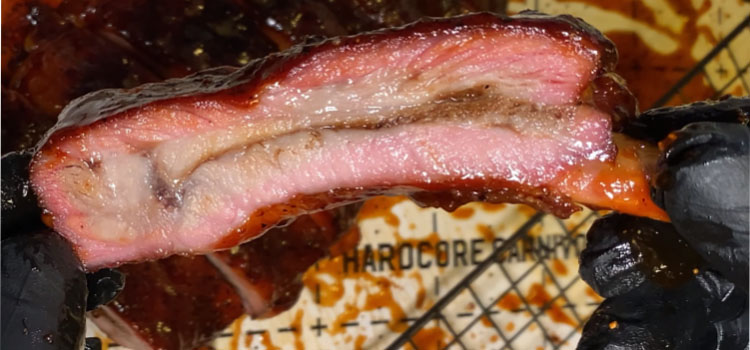Last Updated on September 16, 2024 by Shari Mason
You might’ve noticed pork ribs turn a **pinkish color** after cooking.
This peculiarity, often observed by amateur and seasoned chefs, has raised many eyebrows. So why are ribs pink when cooked? Is it a marker of incomplete cooking or something else?
Out of curiosity, I conducted a few experiments to understand the science and art behind this culinary occurrence.
Why Are Pork Ribs Tinted Pink When Cooked?


Especially in pork and poultry, pink coloration can result from a reaction between the meat’s myoglobin [1] and the heat during cooking.
This is particularly noticeable when smoked or cooked with certain woods, which can contribute to a pinkish hue known as a “smoke ring.”
“Opening a family-style restaurant with comfort food like mac’ n’ cheese, ribs and burgers has always been my dream.”
– Bridget Hall, American Fashion Model
It’s essential to rely on accurate temperature measurements, rather than just color, to determine the doneness and safety of meat.
Related Articles:
- How Long Are Pork Chops Good In The Freezer?
- How Long Is Pork Loin Good In The Fridge?
- How Long Does Pork Belly Last In Fridge?
How Does Cooking Technique Influence Color?
Cooking techniques greatly influence the color of the finished dish. Grilling, for example, often imparts charred or caramelized exteriors due to direct exposure to high heat.
Conversely, smoking can introduce a pink “smoke ring” in meats like pork or beef, resulting from the interaction of the meat’s myoglobin with the wood smoke.
Similarly, slow-cooking methods like braising can retain more of the meat’s natural color, while high-heat searing can produce a rich brown crust.
Are There Natural Pigments In Pork That React To Heat?
Yes, pork [2] contains a natural pigment called myoglobin, responsible for its reddish-pink hue in its raw state. When exposed to heat during cooking, myoglobin undergoes chemical changes.
Depending on factors like pH, oxygen availability, and cooking temperature, this pigment can either darken, turn brown, or retain some pinkish color.
This reaction is especially prominent when the meat is exposed to smoking or specific cooking methods, giving the meat a pink hue even when fully cooked.
Does The Cut Of The Pork Affect Its Color After Cooking?


Yes. The specific cut of pork can influence its color after cooking. Different cuts have varying levels of myoglobin, fat content, and connective tissue.
For instance, muscles that are more frequently used by the animal, like the shoulder, tend to have higher myoglobin content and can appear darker when cooked compared to lesser-used muscles like the loin.
Additionally, fat marbling and connective tissue can impact how the meat cooks and its final appearance, with well-marbled cuts often resulting in juicier, more flavorful outcomes that might retain some pinkness.
What Should We Trust: Color or Temperature?
In essence, while color can be a helpful initial guide, temperature remains the most reliable determinant for the safety and perfection of cooked meat.
We often associate a pink hue with undercooked meat and a brown or white appearance with a fully cooked status. However, this can be misleading.
“In the dance of heat and meat, a pink hue is pork’s sweetest feat; yet in temperature, truth does speak, ensuring our ribs are perfectly unique.”
– Eat Pallet Restaurant & Food Advice
Factors like the meat’s exposure to oxygen, pH, or even the cooking method (such as smoking) can impact its color.
For instance, smoked meats often have a pinkish “smoke ring,” and specific cuts of pork might retain a pink color even when fully cooked.
On the contrary, temperature provides a more definitive and scientific measure of doneness.
A meat thermometer ensures that meat reaches an internal temperature where harmful pathogens, such as Salmonella or E. coli, are destroyed.
Different meats have their recommended safe temperatures, guaranteeing safety and optimal flavor and texture.
FAQs
u003cstrongu003eIs it safe to eat pork while still pink near the bone?u003c/strongu003e
Yes, pink pork near the bone can be safe to eat, provided it has reached the recommended internal temperature of 145°F (63°C) and has been allowed to rest for three minutes after cooking. u003cbru003eu003cbru003eThe pink hue can result from myoglobin, a protein in meat. Always use a meat thermometer to ensure safety rather than relying solely on color.
u003cstrongu003eHow do you know if your ribs are overcooked?u003c/strongu003e
If your ribs are overcooked, they’ll exhibit a few telltale signs. Rather than being tender and juicy, they’ll become dry and tough, making them harder to bite or pull apart. u003cbru003eu003cbru003eOvercooked ribs might also have a burnt or excessively charred exterior. While u0022falling off the boneu0022 is often seen as a sign of perfect ribs, they can be overcooked if the meat falls off without resistance. u003cbru003eu003cbru003eIdeally, ribs should have a slight cling to the bone but release quickly when bitten.
Final Thoughts
The pink hue often observed in cooked pork ribs isn’t a definitive sign of undercooking, as many might assume.
Instead, it’s primarily the result of chemical reactions involving myoglobin, a natural pigment in the meat, especially when exposed to specific cooking methods like smoking.
Understanding this allows for a more informed approach to cooking and consuming pork ribs.
Always use a meat thermometer to ensure proper cooking, placing trust in temperature over color for safety and culinary satisfaction.
References:
- https://www.ncbi.nlm.nih.gov/books/NBK544256/
- https://www.healthline.com/nutrition/foods/pork
- Can You Put an AC Unit in the Kitchen? - September 27, 2024
- What Cheese Does Olive Garden Use? Discover Their Signature - September 27, 2024
- How to Cancel a Pizza Hut Order? Quick & Easy Guide - September 24, 2024


